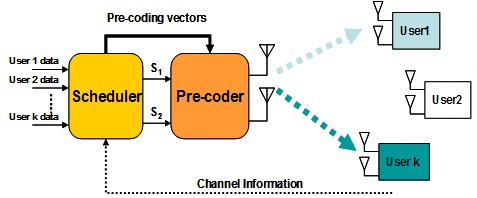 |
| OFDM (Orthogonal Frequency Division Multiplexing) |
Advantages of OFDM
➥Simple implementation➥Overcome Frequency-selective fading
➥No inter-carrier interference (ICI)
Advantages of OFDM is the high spectrum utilization efficiency due to orthogonal sub-carriers need no protect bandwidth. OFDM system support frequency link auto adaptation and scheduling. Easy to combine with MIMO (I will explain about MIMO later).
➥High spectrum efficiency: For the system of traditional frequency division multiplexing (FDM) multi-carrier system, to prevent interference, a guard bandwidth is reserved between each sub-carriers. Therefore, the spectral efficiency is low.
 |
| Advantages of OFDM System |
➥Overcome Multipath effect: It support to prevent the guard interval from destroying the inter-sub-carrier orthogonality, in this effect copy the last part of each OFDM symbol to the front of each symbol with the length of a guard interval, and it form a cyclic prefix (CP). I would like to mention here as long as the delay of each path does not exceed the guard interval of the OFDM technique, the number of wave-forms within the integral time of the FFT is an integer it also shown in below image..
➥Frequency Selective Fading Resistance:The characteristics of frequency selective fading of a multi-path radio channel has been illustrated in the below figure, and the frequency selective fading is caused by multiple paths in OFDM technique.
 |
| Multipath effect in OFDM |
➥Frequency Selective Fading Resistance:The characteristics of frequency selective fading of a multi-path radio channel has been illustrated in the below figure, and the frequency selective fading is caused by multiple paths in OFDM technique.
 |
| Frequency Selective Fading Resistance |
Disadvantages of OFDM Technique
➤The very big weakness of OFDM technique is very sensitivity to frequency offset. The variability of crystal oscillators between the receiver and transmitter will cause ICI. Although the frequency offset can be achieved and corrected through frequency synchronization at the receiver end, the residual frequency offset caused by imprecise offset estimation may degrade the signal detection performance.
➤The PAPR of the OFDM system is un-ignorable at any level, resulting high requirements to the power amplification and wave-clipping.
Basic Idea of SC-FDMA
SC-FDMA technique is just the core part of DFT-S-OFDM, It also can be seen as an OFDM system with a DFT pre-coding. The localized RB distribution makes each customers occupy consecutive part of the whole bandwidth, which looks like a single carrier (SC). |
| SC-FDMS |
I would like to mention the only main points of the benefits of SC-FDMA
➥Low sensitivity to carrier frequency offset
➥Low PAPR
➥Increase the efficiency of PA
➥Increased coverage for power-limited terminal
Weakness of SC-FDMA is Frequency efficiency is lower than OFDM in DL.
➥Low PAPR
➥Increase the efficiency of PA
➥Increased coverage for power-limited terminal
Weakness of SC-FDMA is Frequency efficiency is lower than OFDM in DL.
Why SC-FDMA Adopted in the Uplink
➤Compared with OFDMA technique, with a lower PAPR, SC-FDMA can minimize the requirements of the power amplifier and then helps to control the cost of customer equipment.➥Not fully utilize frequency selectivity, lower frequency selective gain
➥About 2~3 dB lower link performance than OFDM.
Multi-Antenna Technique — MIMO
 |
| MIMO-Multiple-Antenna Tenique |
Advantages of MIMO:
➥Array gain: It increases the transmit power and can be used for beamforming.
➥Diversity gain: It weakens the interference caused by channel fading.
➥Spatial multiplexing gain of the system: It provide doubles the rate within the same bandwidth frame after spatial orthogonal channels are constructed.
Downlink MIMO
➥MIMO is supported in LTE downlink to achieve spatial multiplexing, including single user mode SU-MIMO and multi user mode MU-MIMO.➥In order to improve MIMO performance, pre-coding is used in both SU-MIMO and MU-MIMO to control/reduce the interference among spatial multiplexing data flows.
➥The spatial multiplexing data travelling are scheduled to one single customer. In SU-MIMO, to enhance the transmission rate of data and spectrum efficiency. In MU-MIMO, the data rate flows are scheduled to multi customers and the resources are shared within customers. Multi customers gain can be achieved by customers scheduling in the spatial domain.
 |
| Down Link Details of MIMO |
Uplink MIMO
➥Due to UE cost and power consumption of system, it is very difficult to implement the UL multi transmission system and relative power supply.
➥Virtual-MIMO, in this system the multi single antenna UEs are associated to transmit in the MIMO mode. Virtual-MIMO is still under study.
➥Scheduler assigns the same resource to multi customers. Each customers transmits data by single antenna. MIMO demodulation scheme achieved by the system separates the data by the specific.
➥Scheduler assigns the same resource to multi customers. Each customers transmits data by single antenna. MIMO demodulation scheme achieved by the system separates the data by the specific.
➥Virtual-MIMO can be achieved by the MIMO gain and power gain (higher Tx power in the same time-freq resource). Interference of the multi user or customers data can be controlled by the scheduler system, that is also bring multi user gain.
 |
| Uplink MIMO details in above image |




3 Comments
Due to UE cost and power consumption of system, it is very difficult to implement the UL multi transmission system and relative power supply.
ReplyDeleteVirtual-MIMO, in this system the multi single antenna UEs are associated to transmit in the MIMO mode. Virtual-MIMO is still under study.
Scheduler assigns the same resource to multi customers. Each customers transmits data by single antenna. MIMO demodulation scheme achieved by the system separates the data by the specific.
Virtual-MIMO can be achieved by the MIMO gain and power gain higher Tx power in the same time-freq resource.Interference of the multi user or customers data can be controlled by the scheduler system, that is also bring multi user gain.
Hi-Lo Industrial Trucks Co.
59FF2BBC99
ReplyDeletehacker arıyorum
hacker bulma
tütün dünyası
hacker bulma
hacker kirala
D2874F3881
ReplyDeletetakipçi satın al
m3u listesi
Coin Kazanma
Kafa Topu Elmas Kodu
Brawl Stars Elmas Kodu